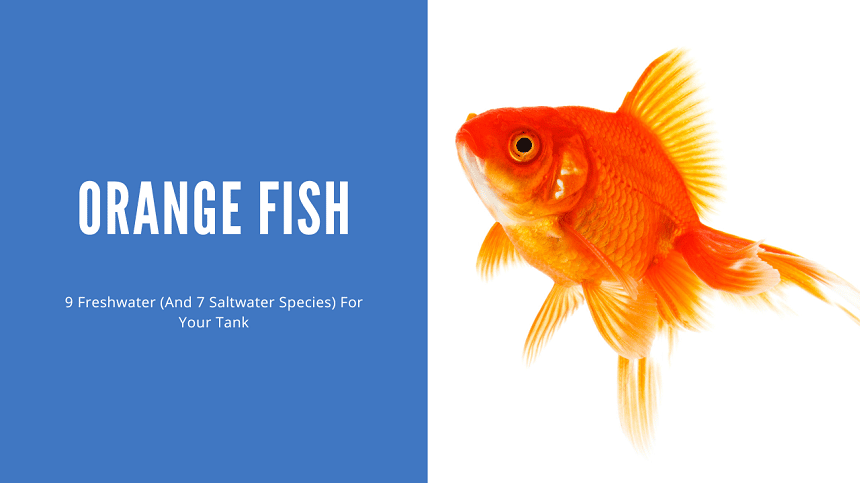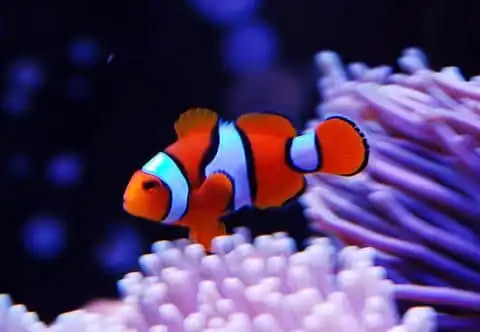Thank you for visiting! By the way… any links on this page that lead to products on Amazon and other stores/partners are affiliate links Aquarium Store Depot earns a commission if you make a purchase.
The color orange is often described as a joyful and energetic shade. Those are two awesome qualities for any aquarium, and what better way to spice up your tank than by adding colorful orange fish? This article introduces 16 amazing orange fish that you can keep.
Get ready; there’s some real eye candy in this article!
Key Takeaways
- There are many species of bright orange fish available in the aquarium trade.
- Many species include yellow, green, and blue patterns, but solid orange fish are available.
- Some orange aquarium fish are peaceful, but others are very aggressive and unsuitable for community tanks.
- Consider tank size, parameters, and temperament before choosing an orange fish for your tank.
Freshwater Orange Fish
Who said freshwater fish species can’t be colorful? These 9 orange freshwater fish will look great in your home aquarium. Just don’t mix them all together. We got a YouTube video from our official YouTube channel below. Keep in mind that some of these fish are mean…
Let’s get started
1. Sunset Thick-lipped Gourami
- Scientific Name: Trichogaster labiosa
- Difficulty Level: Easy
- Temperament: Peaceful
- Adult Size: 4 inches
- Minimum Tank Size: 20 gallons
- Diet: Carnivore
- Origin: Myanmar
- Temperature: 72 – 82 °F
Looking for an awesome orange community fish species with a very peaceful nature? Look no further than the sunset thick-lipped gourami.
These Southeast Asian stunners are not the most common gourami in the hobby, but they are one of the best.
These shy tropical fish will be happiest in a planted aquarium with a low water flow and plenty of hiding places. They will thrive on a diet of regular dried flake food supplemented with live and frozen food like brine shrimp.
2. Honey Gourami
One of the more peaceful Gourami fish available in the hobby. Has a unique yellow coloration and only grows up to 2 inches in length
- Scientific Name: Trichogaster chuna
- Difficulty Level: Moderate
- Temperament: Peaceful
- Adult Size: 2 inches
- Minimum Tank Size: 15 gallons
- Diet: Carnivore
- Origin: India, Bangladesh, Nepal
- Temperature: 72 – 80 °F
The honey gourami is like a smaller, chunkier version of the previous species. They are awesome centerpiece fish for nano aquariums down to about 15 gallons.
These small fish come in many color variations, including golden orange. The males are the most colorful, and they develop intense colors around the breeding season.
3. Variatus Platy

- Scientific Name: Xiphophorus variatus
- Difficulty Level: Easy
- Temperament: Peaceful
- Adult Size: 2 – 2.8 inches
- Minimum Tank Size: 15 gallons
- Diet: Carnivore
- Origin: Mexico
- Temperature: 68 – 79 °F
The variatus platy is an excellent orange fish for beginners to the aquarium hobby. These active fish are great community fish, and you can even breed them at home!
Platy fish are livebearers, which means they give birth to live swimming fish instead of laying eggs. Some of the fry might even grow into beautiful orange adults if you provide loads of hiding places and vegetation.
Variatus platy fish come in many different colors, but look out for the marigold and sunset varieties if you want a burst of orange in your home aquarium. These tropical fish have golden bodies with a darker back half. The area around their tail really pops with intense orange color!
4. Clown Loach
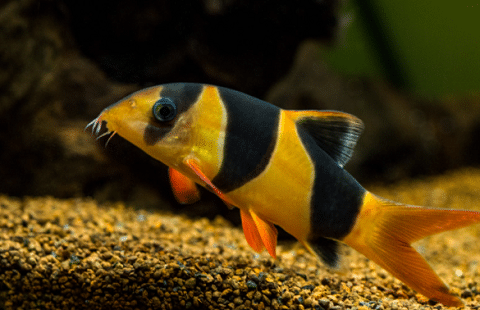
- Scientific Name: Chromobotia macracanthus
- Difficulty Level: Moderate
- Temperament: Semi-aggressive
- Adult Size: 12 inches
- Minimum Tank Size: 150 gallons
- Diet: Omnivore
- Origin: Borneo & Sumatra
- Temperature: 75 – 86 °F
This next species is one for all the monster fish lovers out there. Clown loaches are probably the most colorful loach species in the hobby, but these gorgeous fish need a very large aquarium.
Clown loaches have shark-like fins and a large forked tail, and their exotic orange body and bold black stripes give them a really great contrast. Keep these bright orange fish in with other peaceful, similar-sized tank mates, and enjoy watching their entertaining antics.
5. Goldfish

- Scientific Name: Carassius auratus
- Difficulty Level: Moderate
- Temperament: Peaceful
- Adult Size: 6 inches
- Minimum Tank Size: 30 gallons
- Diet: Omnivore
- Origin: China
- Temperature: 65 – 72 °F
How many fish do you know that are more popular than goldfish? These stunning fish are the first choice for many beginner fish keepers, but they have loads to offer for more experienced aquarists too.
However, this hugely popular aquarium fish species is not the first choice for a community tank, and they require cool water and good filtration to stay happy and healthy.
Goldfish come in many different colors, but the classic orange variety is the brightest. You can choose from loads of different breeds with various color shades, tail, and fin shapes. Some of the most interesting breeds even have strange features like double tail fins, missing dorsal fins, and strange bulging eyes!
6. Red Zebra Mbuna
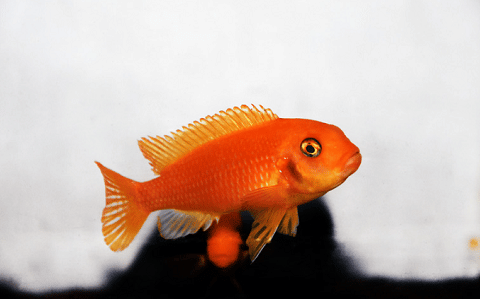
- Scientific Name: Maylandia estherae/ Metriaclima estherae/ Pseudotropheus estherae
- Difficulty Level: Easy
- Temperament: Semi-aggressive
- Adult Size: 5 inches
- Minimum Tank Size: 50 gallons
- Diet: Omnivore
- Origin: Lake Malawi
- Temperature: 75 – 82 °F
The red zebra mbuna is a beautiful and affordable African cichlid from lake Malawi. These colorful fish have a real mean streak so they are not a good choice for a community tank.
However, this species can be kept with their own kind and other species from the mbuna group. Both males and females can have a deep orange body and their bright colors will really catch your attention.
7. Lemon Cichlid

- Scientific Name: Neolamprologus leleupi
- Difficulty Level: Moderate
- Temperament: Semi-aggressive
- Adult Size: 4 inches
- Minimum Tank Size: 30 gallons
- Diet: Omnivore
- Origin: Lake Tanganyika
- Temperature: 72 – 82°F
Lemon cichlids are one of the smaller African cichlids, and also one of the most colorful! Their color ranges from golden yellow to deep orange, and they have a large blue or black mouth.
Keeping these tropical fish over light-colored aquarium gravel tends to bring out the best of their bright colors. This species requires excellent water quality and plenty of caves to really shine.
Lemon cichlids are not especially mean, but they will become aggressive when breeding. They can be kept with other fish species from their native habitat but avoid keeping more than a pair of lemon cichlids unless you have a very large aquarium.
8. Blood Parrot

- Scientific Name: Hybrid
- Difficulty Level: Easy
- Temperament: Semi-aggressive
- Adult Size: 8 inches
- Minimum Tank Size: 55 gallons
- Diet: Omnivore
- Origin: aquarium trade
- Temperature: 72 – 80°F
The blood parrot is an unusual freshwater fish. These Central American cichlids are a hybrid, or mix of various other species, so you’ll never find them swimming free in the wild.
Blood parrot cichlids are strange-looking tropical fish with a small mouth that looks like a parrot’s bill. With their bright orange color and large curious eyes, these interesting fish truly stand out.
The best part is that blood parrots make amazing pets with no shortage of personality.
9. Red Devils
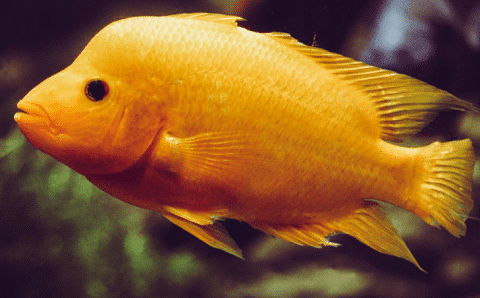
- Scientific Name: Amphilophus labiatus
- Difficulty Level: Moderate
- Temperament: Aggressive
- Adult Size: 12 inches
- Minimum Tank Size: 75 gallons
- Diet: Omnivore
- Origin: Central America
- Temperature: 72 – 77°F
The red devil cichlid is a large Central American species with an attitude that matches its name. These guys are known for their aggressive behavior, and they have a habit of turning their tank upside down, so don’t bother with live plants or fancy aquascapes.
Experts do keep these fish with other species, but you’re better off keeping a single red devil in its own tank and enjoying all the wild personality they bring.
The good news is they are easy to keep if you give them enough room and protect their filter and other equipment from those powerful jaws!
Saltwater
Do you have a saltwater tank? There are some jaw-dropping orange tropical reef fish to choose from.
Some of these fish are great for beginners, but others have a hefty price tag and need expert care. Nevertheless, every fishkeeper can appreciate their amazing looks!
1. Clownfish
Best Choice For Reef Tanks!
Clownfish are hardy, full of personality, and are safe for all corals. They are an icon for any saltwater tank
- Scientific Name: Amphiprion species
- Difficulty Level: Easy
- Temperament: Semi-aggressive
- Adult Size: 3 inches
- Minimum Tank Size: 20 gallons
- Diet: Omnivore
- Origin: Western Pacific & Indian Ocean
- Temperature: 72 – 78°F
- Reef Safe: Yes
- Available As Tank Bred: Yes
Clownfish are an obvious choice for saltwater fish keepers looking for a splash of orange in their reef tank. These small fish can thrive in tanks as small as 20 gallons, and no, they don’t need an anemone to stay happy and healthy.
Many clownfish species are available, and the rise of designer tank-bred specimens means there are some truly breathtaking and unique individuals to choose from.
2. Flame Angelfish

- Scientific Name: Centropyge loricula
- Difficulty Level: Moderate
- Temperament: Semi-aggressive
- Adult Size: 4 inches
- Minimum Tank Size: 70 gallons
- Diet: Omnivore
- Origin: Central Pacific Ocean
- Temperature: 72 – 78 °F
- Reef Safe: With caution
- Available As Tank Bred: Rare/Limited
This incredibly beautiful species is one of the brightest orange fish in the world. These fish also have vertical black bars on their body and electric blue trailing edges of the anal and dorsal fin, and the edge of their tail fin is transparent.
Flame angelfish are not ideal for beginners, and they are not cheap, but this is one fish for every saltwater fish keeper’s wishlist! These fish are omnivores, and they will nip at corals and non-moving invertebrates, which means they are not the safest bet in many reef setups.
3. Carpenter’s Flasher Wrasse

- Scientific Name: Paracheilinus carpenteri
- Difficulty Level: Easy
- Temperament: Peaceful
- Adult Size: 3 inches
- Minimum Tank Size: 55 gallons
- Diet: Carnivore
- Origin: Western Pacific Ocean
- Temperature: 72 – 78 °F
- Reef Safe: Yes
- Available As Tank Bred: No
The Carpenter’s Flasher Wrasse is a wonderful orange fish for a reef aquarium. However, you can expect these fish to change color as they mature. Juveniles are intensely orange but they become more yellow as adults.
Carpenter’s flasher wrasses have an interesting dorsal fin shape that includes a few long flowing rays. The caudal fin is commonly banded in multiple colors. These wrasse fish get along great with other fish in a peaceful reef aquarium.
4. Female Lyretail Anthias

- Scientific Name: Pseudanthias squamipinnis
- Difficulty Level: Moderate
- Temperament: Semi-aggressive
- Adult Size: 5 inches
- Minimum Tank Size: 125 gallons
- Diet: Carnivore
- Origin: Indian & Western Pacific Ocean
- Temperature: 72 – 78 °F
- Reef Safe: Yes
- Available As Tank Bred: Rare/Limited
The lyretail anthias, or sea goldie as it is also known, brings amazing color to any reef aquarium. These schooling fish swim actively and need a large aquarium relative to their body size.
Males are bright red, but females are a shocking orange color that really pops! Females are also more peaceful and can be kept in small groups of 5 or 6. Beware, though, the dominant female will probably develop into a male. Pretty fascinating!
5. Harlequin Tusk
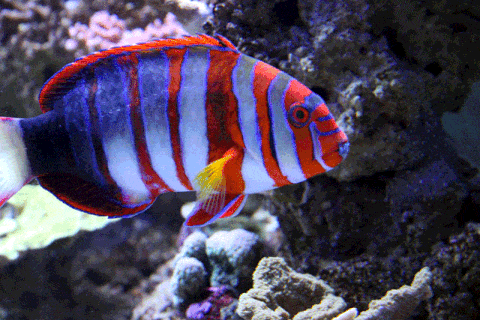
- Scientific Name: Choerodon fasciatus
- Difficulty Level: Moderate
- Temperament: Semi-aggressive
- Adult Size: 10 inches
- Minimum Tank Size: 125 gallons
- Diet: Carnivore
- Origin: Western Pacific
- Temperature: 72 – 78 °F
- Reef Safe: With caution
- Available As Tank Bred: Rare/Limited
The harlequin tusk combines bold orange stripes with pearl white and neon blue. These fish have some serious dentition too, and even their teeth are colorful. That’s right; harlequin tusks get their name from their electric blue dagger-like fangs.
These saltwater fish are safe with corals and other semi-aggressive fish that can hold their own, but they will snack on inverts and bully smaller peaceful fish. Keep this species as a show-stopping centerpiece fish.
6. Copper Band Butterfly

- Scientific Name: Chelmon rostratus
- Difficulty Level: Expert only
- Temperament: Peaceful
- Adult Size: 8 inches
- Minimum Tank Size: 125 gallons
- Diet: Carnivore
- Origin: Pacific & Indian Oceans
- Temperature: 72 – 78 °F
- Reef Safe: With caution
- Available As Tank Bred: No
The Copper banded butterflyfish is one of the most beautiful and distinctive saltwater species in the world. This flattened fish has a small head, with a strange shape. Their long snout and tiny mouth make this species very difficult to feed.
They have a specialized diet, but their ability to control the population of pesky glass anemones makes them very popular with experienced reef keepers. These butterfly fish have been bred in captivity, but they are not yet commercially available.
7. Miniatus Grouper
- Scientific Name: Cephalopholis miniatus
- Difficulty Level: Moderate
- Temperament: Aggressive
- Adult Size: 14 inches
- Minimum Tank Size: 180 gallons
- Diet: Carnivore
- Origin: West Pacific & Indian Oceans
- Temperature: 72 – 78 °F
- Reef Safe: With caution
- Available As Tank Bred: No
The Miniatus grouper (video source) is a spectacular bright orange fish species. This tropical fish has a deep orange body covered in neon blue spots for amazing contrast.
However, miniatus groupers are the wrong choice if you keep any smaller fish or invertebrates. These dazzling fish grow to over a foot long, and they have a large bucket mouth, so stick to similar-sized tank mates.
Bonus Species
Looking for even more orange aquarium fish? Check out these bonus fresh and saltwater species!
Nano & Schooling Fish
- Orange betta fish
- orange guppies
- Harlequin rasbora
- Glowlight tetra
Cichlids
- Jewel cichlid
- Midas cichlid
- Golden German blue ram
Saltwater
- Dispar anthias
- Flame hawkfish
- Citrinis clown goby
FAQs
What Tropical Fish Are Orange?
There are many fresh and saltwater fish species with bright orange colors, including popular species that you probably already know. Orange betta fish and orange guppies are two great examples.
What Kind Of Fish Are Orange And White?
There are many fresh and saltwater fish species with bright orange colors, including popular species that you probably already know. Orange betta fish and orange guppies are two great examples.
What Kinds Of Fish Are Orange?
Goldfish are probably the most familiar orange aquarium fish in the world. However, there are dozens of other popular aquarium fish in the hobby with orange colors. There are various types of gouramis, guppies, cichlids, and even betta fish that have orange colors.
What Tetras Are Orange?
Tetras are excellent community fish, and their small size makes them a great choice for aquarists who don’t have room for a huge tank. The ember, serpae, and glowlight tetra are all beautiful schooling fish for peaceful community tanks.
Final Thoughts
Putting together a color-themed aquarium is great fun, and with such an amazing variety of aquarium fish out there, you can find fish of any color.
Orange fish are especially eye-catching, and with the 16 awesome fish in this post, you can take your fresh or saltwater aquarium to the next level!
What’s your favorite orange fish? Let us know in the comments below!

